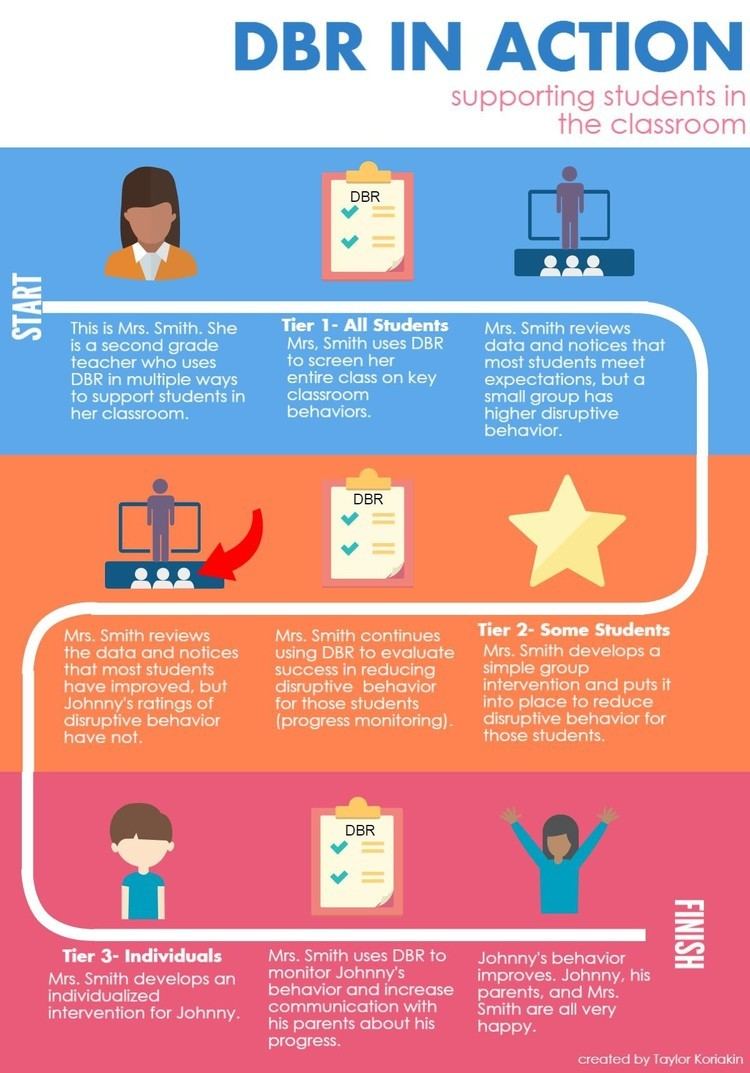 | ||
Direct Behavior Rating (DBR) is a behavior assessment method used by educational professionals such as school psychologists and teachers to monitor student behavior, and is characterized by: (a) recording a rating immediately after a prespecified observation period, (b) utilizing a rater who has firsthand experience with the individual being rated for the duration of the observation period (e.g., the rater is a teacher in a classroom wherein one student is the target), and (c) requiring "minimal inference" on the part of the rater to discern behaviors of interest. For instance, if a teacher was concerned about a student's disruptive behavior during math class and wanted to collect data on their behavior, they could explicitly define "disruptive behavior", observe the student's behavior during typical math instruction, and at the end of class, record for what percentage of time the student displayed disruptive behavior. This is an example of DBR using a Single Item Scale, or DBR-SIS.
Direct Behavior Rating typically involves four steps:
- specifying a target behavior that one wishes to monitor
- rating that behavior following a specified observation period
- sharing the obtained information across individuals (e.g., parents, teachers, students)
- utilizing the outcome data to monitor the target behavior over time
Direct Behavior Rating represents an amalgamation of characteristics from two major types of behavior collection systems: systematic direct observation and behavior rating scales. According to a survey performed in 2006, over 60% of classroom teachers report that they employ DBR or DBR-like tools within their classrooms and view it as a highly acceptable intervention tool. Recent research further indicates the acceptability of the measure to school psychologists who are frequently responsible for monitoring the effectiveness of research-based classroom interventions.
DBR is not restricted to a single form of assessment; rather, it is a methodology that can be utilized with a wide range of behaviors, contexts, and applications. One common distinction is made between DBR scales that consist of solely one item representing a behavioral construct (i.e., disruptive behavior) (Single Item Scales, or DBR-SIS) and those that consist of multiple items which are individually scored and then aggregated to depict a single construct (i.e., "Inappropriately calls out during instruction", "Pokes other students during instruction") (Multiple Item Scales, or DBR-MIS). The majority of DBR research has focused on the Single Item Scale format, the content of which is intended to be flexibly determined based on the rating's context and then graphed and summarized independently of other Single Item Scales. While each DBR-SIS individually measures a single behavioral construct, the utility of utilizing multiple Single Item Scales to act as general outcome measures for school-based social behavior has also been examined.
Research has also investigated the feasibility of incorporating DBR into intervention packages; one study utilized DBR as a combined intervention/assessment tool through its use as a self-monitoring intervention. Literature examining the use of daily behavior report cards or daily progress reports often utilize DBR methodology as an integral part of their intervention and assessment construction. More resources regarding behavior report cards are available at:
Given its promising psychometric properties, contextual relevance, and usability by practitioners with restricted resources (e.g., teachers), DBR has also been suggested as a possible assessment tool within multi-tiered intervention frameworks such as Response to Intervention.
